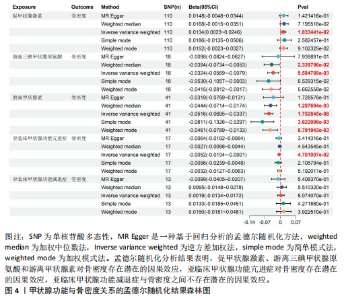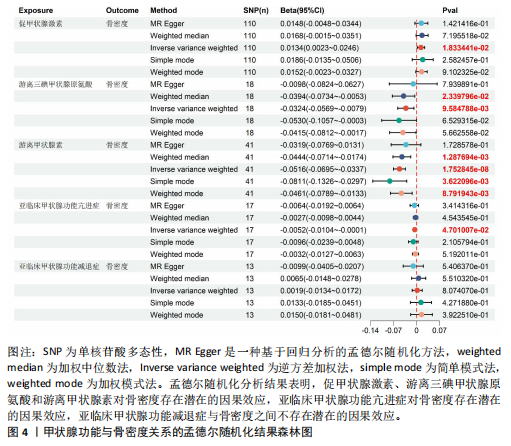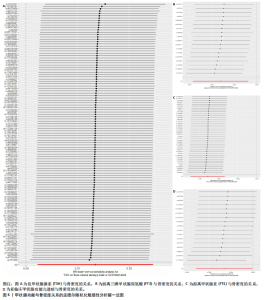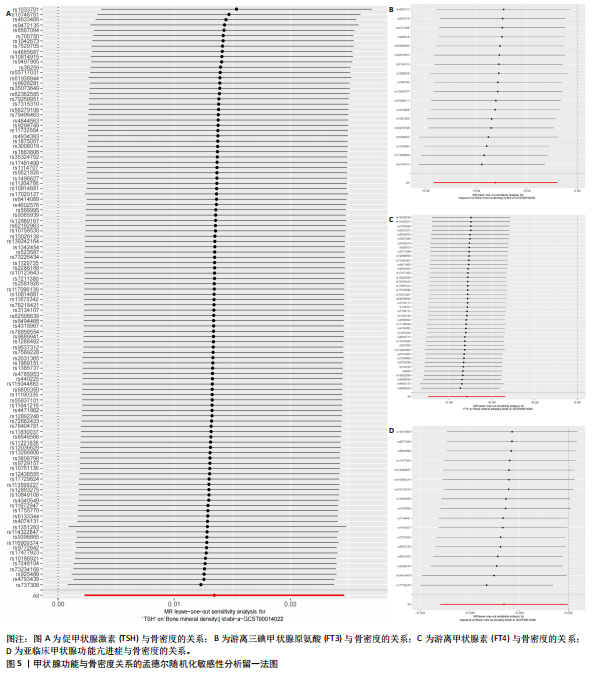Chinese Journal of Tissue Engineering Research ›› 2026, Vol. 30 ›› Issue (4): 1019-1027.doi: 10.12307/2026.548
Previous Articles Next Articles
Association between thyroid function and osteoporosis: genome-wide data analysis of European populations
Zeng Hao1, Sun Pengcheng1, Chai Yuan2, Huang Yourong2, Zhang Chi2, Zhang Xiaoyun2
- 1Guangxi University of Chinese Medicine, Nanning 530001, Guangxi Zhuang Autonomous Region, China; 2Department of Orthopedics, Ruikang Hospital, Guangxi University of Chinese Medicine, Nanning 530011, Guangxi Zhuang Autonomous Region, China
-
Received:2024-09-18Accepted:2024-12-23Online:2026-02-08Published:2025-05-22 -
Contact:Zhang Xiaoyun, MD, Associate chief physician, Master’s supervisor, Department of Orthopedics, Ruikang Hospital, Guangxi University of Chinese Medicine, Nanning 530011, Guangxi Zhuang Autonomous Region, China Co-corresponding author: Zhang Chi, MD, Attending physician, Department of Orthopedics, Ruikang Hospital, Guangxi University of Chinese Medicine, Nanning 530011, Guangxi Zhuang Autonomous Region, China -
About author:Zeng Hao, Master candidate, Guangxi University of Chinese Medicine, Nanning 530001, Guangxi Zhuang Autonomous Region, China -
Supported by:National Natural Science Foundation of China, No. 82405434 (to ZC); Guangxi Natural Science Foundation (General Program), No. 2023GXNSFAA026075 (to ZXY); Doctoral Start-up Foundation of Guangxi University of Traditional Chinese Medicine, No. 2023BS043 (to ZC); Guangxi Traditional Chinese Medicine Appropriate Technology Development and Promotion Project, No. GZSY22-36 (to ZXY); Guangxi University of Chinese Medicine Youth Innovation Research Team Project, No. 2021TD001 (to ZXY); Huang Yourong GUI School of Traditional Chinese Medicine Master Training Project, No. [2022]6 (to HYR)
CLC Number:
Cite this article
Zeng Hao, Sun Pengcheng, Chai Yuan, Huang Yourong, Zhang Chi, Zhang Xiaoyun. Association between thyroid function and osteoporosis: genome-wide data analysis of European populations[J]. Chinese Journal of Tissue Engineering Research, 2026, 30(4): 1019-1027.
share this article
Add to citation manager EndNote|Reference Manager|ProCite|BibTeX|RefWorks
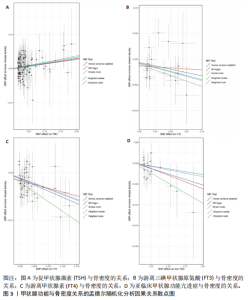
2.1 工具变量 根据此次研究工具变量的筛选标准,首先从暴露数据中筛选出与暴露强相关且无连锁不平衡的SNPs作为工具变量,然后分别从骨密度中提取结局数据,并将等位基因对齐,删除中等基因频率的回文序列,利用Radial-MR包识别并剔除异常值,同时用LDlink数据库手动筛选和删除与混杂因素(吸烟、糖尿病等)和骨密度结局相关的SNPs,最终纳入孟德尔随机化分析的SNPs数如下:促甲状腺激素110个SNPs,游离三碘甲状腺原氨酸18个SNPs,游离甲状腺素41个SNPs,亚临床甲状腺功能亢进症17个SNPs,亚临床甲状腺功能减退症18个SNPs。 2.2 甲状腺功能对骨密度的影响 逆方差加权法分析结果显示,促甲状腺激素(β=0.013 4,95%CI:0.002 3-0.024 6,P=1.83×10-2)、游离三碘甲状腺原氨酸(β=-0.032 4,95%CI:-0.056 9至-0.007 9,P=9.58×10-3)和游离甲状腺素(β=-0.051 6,95%CI:-0.069 5至-0.033 7,P=1.83×10-2)对骨密度存在潜在的因果效应。同时,此次研究使用其他4种方法来加强结果的稳健性,其中加权中位数法支持游离三碘甲状腺原氨酸与骨密度相关,加权中位数法、简单模式法、加权模式法支持游离甲状腺素与骨密度相关,虽然MR-Egger法等方法并不支持上述结论,但此次研究发现其他4种方法因果效应的方向均与逆方差加权法一致,其散点图结果也显示出5种方法因果效应方向的一致性,见图3。孟德尔随机化结果森林图见图4。 2.3 亚临床甲状腺功能障碍对骨密度的影响 逆方差加权法结果显示,基因预测的亚临床甲状腺功能亢进症对骨密度(β=-0.005 2,95%CI:-0.010 4至-0.000 1,P=4.70×10-2)存在潜在的因果效应,尽管其他4种方法未能支持该结论,但其因果效应的方向与逆方差加权法一致。孟德尔随机化分析并未发现亚临床甲状腺功能减退症与骨密度之间的因果效应。 2.4 药物介导的甲状腺功能障碍对骨质疏松的影响 此次研究分析了药物作为从甲状腺功能障碍到骨质疏松途"
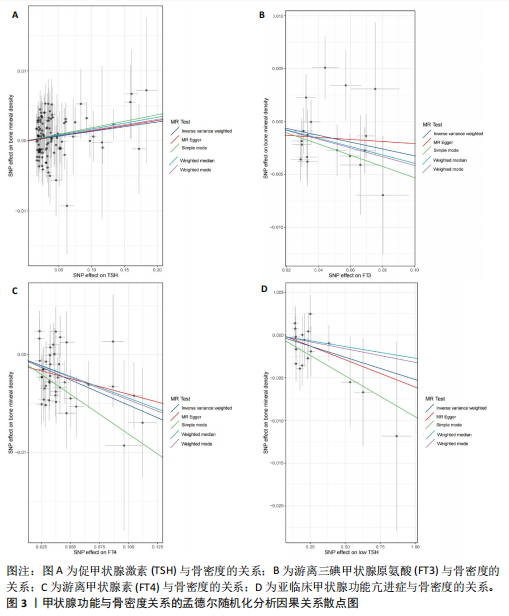
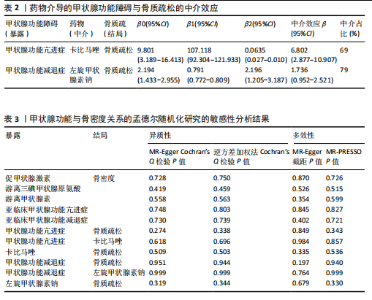
径的介质,其效应值源自逆方差加权法的Beta系数,如表2所示,通过两步孟德尔随机化分析,计算了卡比马唑(中介效应:6.802,95%CI:2.877-10.907)在甲状腺功能亢进症与骨质疏松风险之间的因果关系中的潜在中介效应,其中介占比为69%,这一比例表明在甲状腺功能亢进症增加骨质疏松风险的总体效应中,有69%是通过服用抗甲状腺药物卡比马唑这一中介路径实现的,这是一个相当高的比例,表明卡比马唑在治疗甲状腺功能亢进症过程中可能对骨质健康产生间接影响;同时,也计算了左旋甲状腺素钠(中介效应:1.736,95%CI:0.952-2.521)在甲状腺功能减退症与骨质疏松风险之间因果关系中的潜在中介效应,其中介占比为79%,这一比例表明在甲状腺功能减退症增加骨质疏松风险的总体效应中,有79%是通过服用甲状腺激素替代药物左旋甲状腺素钠这一中介路径实现的。 2.5 敏感性分析 在筛选工具变量的过程中,此次研究筛选了F统计量> 10的工具变量,以避免弱工具变量对此次研究结果产生偏倚;根据Cochran’s Q检验,逆方差加权法和MR-Egger分析结果P > 0.05,未发现工具变量在从暴露到结局的过程中存在显著的异质性;MR-Egger截距测试和MR-PRESSO分析结果也表明此次研究不存在潜在的水平多效性(P > 0.05),敏感性分析结果见表3。此外,留一法分析并未检测到存在单个SNPs对整体因果估计效应产生影响,见图5。以上敏感性分析均保证了此次研究结果的稳健性。"
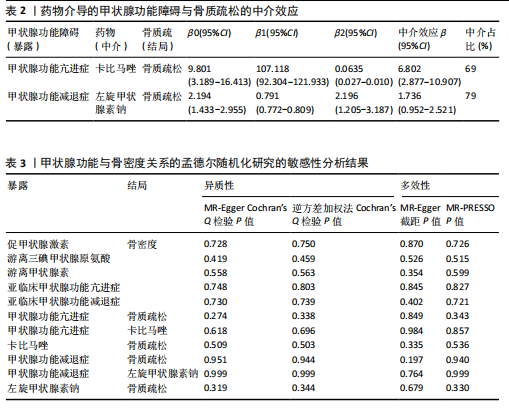
| [1] COMPSTON JE, MCCLUNG MR, LESLIE WD. Osteoporosis. Lancet. 2019;393(10169): 364-376. [2] MARTINIAKOVA M, MONDOCKOVA V, KOVACOVA V, et al. Interrelationships among metabolic syndrome, bone-derived cytokines, and the most common metabolic syndrome-related diseases negatively affecting bone quality. Diabetol Metab Syndr. 2024;16(1):217. [3] KHANDELWAL S, LANE NE. Osteoporosis: Review of Etiology, Mechanisms, and Approach to Management in the Aging Population. Endocrinol Metab Clin North Am. 2023;52(2):259-275. [4] TRAJANOSKA K, MORRIS JA, OEI L, et al. Assessment of the genetic and clinical determinants of fracture risk: genome wide association and mendelian randomisation study. BMJ. 2018;362:k3225. [5] 中华医学会骨质疏松和骨矿盐疾病分会. 中国骨质疏松症流行病学调查及“健康骨骼”专项行动结果发布[J]. 中华骨质疏松和骨矿盐疾病杂志,2019,12(4):317-318. [6] BORGSTROM F, KARLSSON L, ORTSATER G, et al. Fragility fractures in Europe: burden, management and opportunities. Arch Osteoporos. 2020;15(1):59. [7] DELITALA AP, SCUTERI A, DORIA C. Thyroid Hormone Diseases and Osteoporosis. J Clin Med. 2020;9(4):1034. [8] BORO H, MANNAR V, MALHOTRA R, et al. Trabecular bone score and bone mineral density as indices of skeletal fragility in endogenous Cushing’s syndrome. Clin Endocrinol (Oxf). 2023;99(3):253-261. [9] ZHANG Z, DUAN Y, HUO J. Lipid Metabolism, Methylation Aberrant, and Osteoporosis: A Multi-omics Study Based on Mendelian Randomization. Calcif Tissue Int. 2024; 114(2):147-156. [10] 章晓云,曾浩,黎征鹏,等.骨质疏松症的发病机制及中医药治疗研究进展[J].中国实验方剂学杂志,2025,31(1):311-320. [11] BABIC LM, GUNJACA I, PLEIC N, et al. Environmental Factors Affecting Thyroid-Stimulating Hormone and Thyroid Hormone Levels. Int J Mol Sci. 2021;22(12):6521. [12] BIONDI B, CAPPOLA AR. Subclinical hypothyroidism in older individuals. Lancet Diabetes Endocrinol. 2022;10(2):129-141. [13] CAPPOLA AR, AUCHUS RJ, EL-HAJJ FG, et al. Hormones and Aging: An Endocrine Society Scientific Statement. J Clin Endocrinol Metab. 2023;108(8):1835-1874. [14] KAHALY GJ. Management of Graves Thyroidal and Extrathyroidal Disease: An Update. J Clin Endocrinol Metab. 2020; 105(12):3704-3720. [15] 黄倩,方坚,阮梅,等. 抗甲状腺药物所致肝损伤的研究进展[J]. 药物评价研究, 2024,47(5):927-932. [16] CHEN LG, TUBBS JD, LIU Z, et al. Mendelian randomization: causal inference leveraging genetic data. Psychol Med. 2024;19:1-14. [17] SKRIVANKOVA VW, RICHMOND RC, WOOLF B, et al. Strengthening the Reporting of Observational Studies in Epidemiology Using Mendelian Randomization: The STROBE-MR Statement. JAMA. 2021;326(16):1614-1621. [18] KARLSSON T, RASK-ANDERSEN M, PAN G, et al. Contribution of genetics to visceral adiposity and its relation to cardiovascular and metabolic disease. Nat Med. 2019; 25(9):1390-1395. [19] LIU C, SHEN J, DING Z, et al. Association between hypothyroidism and nephrotic syndrome: a bidirectional two-sample Mendelian randomization analysis. Ren Fail. 2024;46(2):2390558. [20] OGUNDIPE V, GROEN AH, HOSPER N, et al. Generation and Differentiation of Adult Tissue-Derived Human Thyroid Organoids. Stem Cell Reports. 2021;16(4):913-925. [21] ZHU S, PANG Y, XU J, et al. Endocrine Regulation on Bone by Thyroid. Front Endocrinol (Lausanne). 2022;13:873820. [22] CARTER AR, SANDERSON E, HAMMERTON G, et al. Mendelian randomisation for mediation analysis: current methods and challenges for implementation. Eur J Epidemiol. 2021;36(5):465-478. [23] LEADER A, AYZENFELD RH, LISHNER M, et al. Thyrotropin levels within the lower normal range are associated with an increased risk of hip fractures in euthyroid women, but not men, over the age of 65 years. J Clin Endocrinol Metab. 2014;99(8):2665-2673. [24] MURPHY E, GLUER CC, REID DM, et al. Thyroid function within the upper normal range is associated with reduced bone mineral density and an increased risk of nonvertebral fractures in healthy euthyroid postmenopausal women. J Clin Endocrinol Metab. 2010;95(7):3173-3181. [25] NOH HM, PARK YS, LEE J, et al. A cross-sectional study to examine the correlation between serum TSH levels and the osteoporosis of the lumbar spine in healthy women with normal thyroid function. Osteoporos Int. 2015;26(3):997-1003. [26] HWANGBO Y, KIM JH, KIM SW, et al. High-normal free thyroxine levels are associated with lowtrabecular bone scores in euthyroid postmenopausal women. Osteoporos Int. 2016;27(2):457-462. [27] BIONDI B, COOPER DS. Subclinical Hyperthyroidism. N Engl J Med. 2018; 378(25):2411-2419. [28] BLUM MR, BAUER DC, COLLET TH, et al. Subclinical thyroid dysfunction and fracture risk: a meta-analysis. JAMA. 2015; 313(20):2055-2065. [29] KAHALY GJ, DIANA T, OLIVO PD. TSH receptor antibodies: relevance & utility. Endocr Pract. 2020;26(1):97-106. [30] KIM SM, SULTANA F, KORKMAZ F, et al. Independent Skeletal Actions of Pituitary Hormones. Endocrinol Metab (Seoul). 2022;37(5):719-731. [31] ABE E, MARIANS RC, YU W, et al. TSH is a negative regulator of skeletal remodeling. Cell. 2003;115(2):151-162. [32] BOUTIN A, ELISEEVA E, GERSHENGORN MC, et al. beta-Arrestin-1 mediates thyrotropin-enhanced osteoblast differentiation. FASEB J. 2014;28(8):3446-3455. [33] CHEN S, HUANG W, ZHOU G, et al. Association between Sensitivity to Thyroid Hormone Indices and Bone Mineral Density in US Males. Int J Endocrinol. 2022;2022: 2205616. [34] LIN JD, PEI D, HSIA TL, et al. The relationship between thyroid function and bone mineral density in euthyroid healthy subjects in Taiwan. Endocr Res. 2011;36(1):1-8. [35] KESER I, CVIJETIC S, BITUH M, et al. Vitamin D and parathyroid hormone in relation to bone health in Croatian women. Arch Osteoporos. 2018;13(1):69. [36] YOU H, SHIN HR, SONG S, et al. Vitamin D intake and bone mineral density in Korean adults: analysis of the 2009-2011 Korea National Health and Nutrition Examination Survey. Nutr Res Pract. 2022;16(6):775-788. [37] GRUNDMANN SM, BRANDSCH C, ROTTSTADT D, et al. The High Calcium, High Phosphorus Rescue Diet Is Not Suitable to Prevent Secondary Hyperparathyroidism in Vitamin D Receptor Deficient Mice. Front Physiol. 2017;8:212. [38] CARLE A, KARMISHOLT JS, KNUDSEN N, et al. Does Subclinical Hypothyroidism Add Any Symptoms? Evidence from a Danish Population-Based Study. Am J Med. 2021;134(9):1115-1126. [39] GIANNAKOPOULOS A, KATSANTONI E, KRITIKOU D, et al. Osteoprotegerin levels in children with subclinical hypothyroidism. Acta Paediatr. 2020;109(12):2770-2774. [40] MOHAMED AH, NAJI NS, AL-SAADI AH. Study of the relationship between FT3, FT4, and TSH with bone resorption indices in men with hypothyroidism. J Popul Ther Clin Pharmacol. 2022;29(2):e33-e39. [41] HOLLEY M, RAZVI S, FAROOQ MS, et al. Cardiovascular and bone health outcomes in older people with subclinical hypothyroidism treated with levothyroxine: a systematic review and meta-analysis. Syst Rev. 2024;13(1):123. [42] GONZALEZ R E, STUBER M, DEL GC, et al. Skeletal Effects of Levothyroxine for Subclinical Hypothyroidism in Older Adults: A TRUST Randomized Trial Nested Study. J Clin Endocrinol Metab. 2020;105(1):dgz58. [43] GONZALEZ-RODRIGUEZ LA, FELICI-GIOVANINI ME, HADDOCK L. Thyroid dysfunction in an adult female population: A population-based study of Latin American Vertebral Osteoporosis Study (LAVOS) - Puerto Rico site. P R Health Sci J. 2013;32(2):57-62. [44] USMAN R, ISMAIL S, TAHIR R, et al. Efficacy Of Different Dosage Regimens Of Carbimazole In The Treatment Of Primary Hyperthyroidism. J Ayub Med Coll Abbottabad. 2021;33(2):244-247. [45] UPADHYAY U, VORA PA, PATEL R, et al. Levothyroxine Sodium - Thyroid Hormone Replacement Therapy for Hypothyroidism: A Review of Patent Literature. Recent Pat Biotechnol. 2023;17(3):245-256. [46] BUCHI AE, FELLER M, NETZER S, et al. Bone geometry in older adults with subclinical hypothyroidism upon levothyroxine therapy: A nested study within a randomized placebo controlled trial. Bone. 2022;161:116404. |
| [1] | Wen Guangwei, Zhen Yinghao, Zheng Taikeng, Zhou Shuyi, Mo Guoye, Zhou Tengpeng, Li Haishan, Lai Yiyi. Effects and mechanisms of isoginkgetin on osteoclastogenesis [J]. Chinese Journal of Tissue Engineering Research, 2026, 30(6): 1348-1358. |
| [2] | Yang Zhijie, Zhao Rui, Yang Haolin, Li Xiaoyun, Li Yangbo, Huang Jiachun, Lin Yanping, Wan Lei, HuangHongxing. Postmenopausal osteoporosis: predictive values of muscle mass, grip strength, and appendicular skeletal muscle index [J]. Chinese Journal of Tissue Engineering Research, 2026, 30(5): 1073-1080. |
| [3] | Zhou Jian, Zhang Tao, Zhou Weili, Zhao Xingcheng, Wang Jun, Shen Jie, Qian Li, Lu Ming. Effects of resistance training on quadriceps mass and knee joint function in patients with osteoporosis and sarcopenia [J]. Chinese Journal of Tissue Engineering Research, 2026, 30(5): 1081-1088. |
| [4] | Gao Zengjie, , Pu Xiang, Li Lailai, Chai Yihui, Huang Hua, Qin Yu. Increased risk of osteoporotic pathological fractures associated with sterol esters: evidence from IEU-GWAS and FinnGen databases [J]. Chinese Journal of Tissue Engineering Research, 2026, 30(5): 1302-1310. |
| [5] | Liu Fengzhi, Dong Yuna, Tian Wenyi, Wang Chunlei, Liang Xiaodong, Bao Lin. Gene-predicted associations between 731 immune cell phenotypes and rheumatoid arthritis [J]. Chinese Journal of Tissue Engineering Research, 2026, 30(5): 1311-1319. |
| [6] | Zhang Cuicui, Chen Huanyu, Yu Qiao, Huang Yuxuan, Yao Gengzhen, Zou Xu. Relationship between plasma proteins and pulmonary arterial hypertension and potential therapeutic targets [J]. Chinese Journal of Tissue Engineering Research, 2026, 30(5): 1331-1340. |
| [7] | Cao Wenqi, Feng Xiuzhi, Zhao Yi, Wang Zhimin, Chen Yiran, Yang Xiao, Ren Yanling. Effect of macrophage polarization on osteogenesis-angiogenesis coupling in type 2 diabetic osteoporosis [J]. Chinese Journal of Tissue Engineering Research, 2026, 30(4): 917-925. |
| [8] | Rong Xiangbin, , Zheng Haibo, Mo Xueshen, Hou Kun, Zeng Ping, . Plasma metabolites, immune cells, and hip osteoarthritis: causal inference based on GWAS data from European populations [J]. Chinese Journal of Tissue Engineering Research, 2026, 30(4): 1028-1035. |
| [9] | He Qiwang, , , Chen Bo, Liang Fuchao, Kang Zewei, Zhou Yuan, Ji Anxu, Tang Xialin, . Relationship between Alzheimer’s disease and sarcopenia and body mass index: analysis of GWAS datasets for European populations [J]. Chinese Journal of Tissue Engineering Research, 2026, 30(4): 1036-1046. |
| [10] | Ding Yu, Chen Jingwen, Chen Xiuyan, Shi Huimin, Yang Yudie, Zhou Meiqi, Cui Shuai, . Circulating inflammatory proteins and myocardial hypertrophy: large sample analysis of European populations from GWAS Catalog and FinnGen databases [J]. Chinese Journal of Tissue Engineering Research, 2026, 30(4): 1047-1057. |
| [11] | Xu Jiamu, Yang Cheng, Li Weimin, Wang Chunqing. Role and pathogenesis of pyroptosis and inflammatory factors in osteoporosis [J]. Chinese Journal of Tissue Engineering Research, 2026, 30(3): 691-700. |
| [12] | Zhao Feifan, Cao Yujing. An artificial neural network model of ankylosing spondylitis and psoriasis shared genes and machine learning-based mining and validation [J]. Chinese Journal of Tissue Engineering Research, 2026, 30(3): 770-784. |
| [13] | Liu Chu, Qiu Boyuan, Tong Siwen, He Linyuwei, Chen Haobo, Ou Zhixue. A genetic perspective reveals the relationship between blood metabolites and osteonecrosis: an analysis of information from the FinnGen database in Finland [J]. Chinese Journal of Tissue Engineering Research, 2026, 30(3): 785-794. |
| [14] | Wang Meng, Lu Tan, Li Minjie, Liu Zhicheng, Guo Xiaoyong. Finite element analysis of stress distribution of anchors at different implantation depths under different bone density conditions in rotator cuff tears [J]. Chinese Journal of Tissue Engineering Research, 2026, 30(3): 561-569. |
| [15] | Yang Fengli, Zhou Chao, Xiong Wei, Zhou Yuxiang, Li Dengshun, Wang Xin, Li Zhanzhen. 3D printed poly-L-lactic acid bone scaffolds in repair of bone defects [J]. Chinese Journal of Tissue Engineering Research, 2026, 30(2): 507-515. |
| Viewed | ||||||
|
Full text |
|
|||||
|
Abstract |
|
|||||
